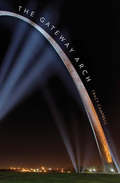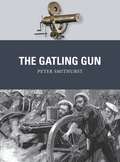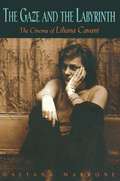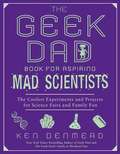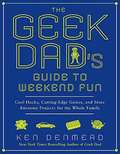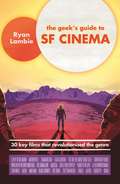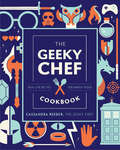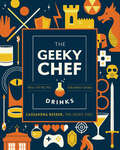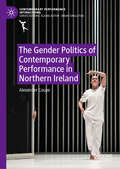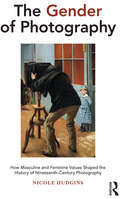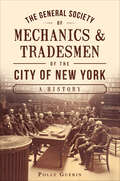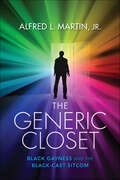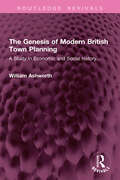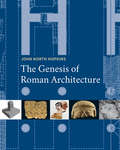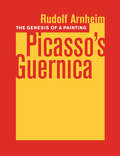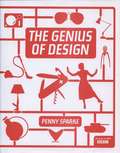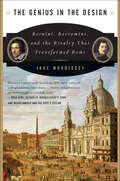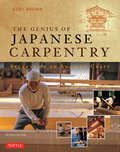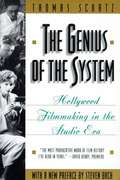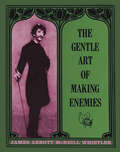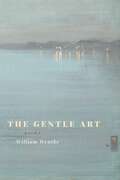- Table View
- List View
The Gateway Arch: A Biography (Icons of America)
by Tracy CampbellThis &“fascinating, engaging&” history of St. Louis&’s monument to American expansion reveals a story of greed, discrimination, and community displacement (NextSTL.com). Rising to a triumphant height of 630 feet, the Gateway Arch is one of the world&’s most widely recognized structures and attracts millions of tourists to St. Louis every year. Envisioned in 1947 but not completed until the mid-1960s, its story is one of innovation and greed; civic pride and backroom deals. Weaving together social, political, and cultural perspectives, historian Tracy Campbell uncovers the complicated and troubling history of this iconic symbol. In this revealing account, Campbell shows that the so-called Gateway to the West was the scheme of shrewd city leaders who were willing to steal an election, destroy historic buildings, and drive out communities in order to make downtown St. Louis more profitable. Campbell also tells the human story of the architect Eero Saarinen, whose prize-winning design brought him acclaim but also charges of plagiarism, and who didn&’t live to see the completion of his vision.
The Gatling Gun
by Johnny Shumate Peter SmithurstA unique chapter in the history of firearms, the multibarrel, hand-cranked Gatling gun was one of the first practical rapid-fire weapons ever to be used in battle. It changed warfare by introducing the capability to project deadly, high-intensity fire on the battlefield, and portended the devastation that automatic weapons would wreak in World War I. During its 40-year career, it saw widespread service with US, British, and other forces on a host of battlefields through conflicts in Zululand and the American West, to the Spanish-American War. Although it saw widespread use in the hands of industrialized nations against various groups of indigenous native warriors, it was famously left behind by Custer at the Battle of Little Bighorn, where some argue it could have made all the difference. Featuring full-color artwork plus contemporary and close-up photographs, this engaging study investigates the origins, development, combat use, and lasting influence of the formidable Gatling gun.
The Gaze and the Labyrinth: The Cinema of Liliana Cavani
by Gaetana MarroneIn this, the first comprehensive book on Liliana Cavani, Gaetana Marrone redraws the map of postwar Italian cinema to make room for this extraordinary filmmaker, whose representations of transgressive eroticism, spiritual questing, and psychological extremes test the limits of the medium, pushing it into uncharted areas of discovery. Cavani's film The Night Porter (1974) created a sensation in the United States and Europe. But in many ways her critically renowned endeavors--which also include Francesco di Assisi, Galileo, I cannibali, Beyond Good and Evil, The Berlin Affair, and several operas and documentaries--remain enigmatic to audiences. Here Marrone presents Cavani's work as a cinema of ideas, showing how it takes pleasure in the telling of a story and ultimately revolts against all binding ideological and commercial codes. The author explores the rich visual language in which Cavani expresses thought, and the cultural icons that constitute her style and images. This approach affords powerful insights into the intricate interlacing of narrated events. We also come to understand the importance assigned to the gaze in the genesis of desire and the acquisition of knowledge. The films come to life in this book as the classical tragedies Cavani intended, where rebels and madmen experience conflict between historical and spiritual reality, the present and the past. Offering intertextual analyses within such fields as psychology, history, and cultural studies, along with production information gleaned from Cavani's personal archives, Marrone boldly advances our understanding of an intriguing, important body of cinematic work.
The Geek Dad Book for Aspiring Mad Scientists
by Ken DenmeadFans of the New York Times bestselling Geek Dad and The Geek Dad's Guide to Weekend Fun will flock to the 3.0 version, The Geek Dad Book for Aspiring Mad Scientists. As Ken Denmead explains, most kids lack an understanding of science and an awareness of how it influences our everyday lives. What kids today need is a fun way to learn scientific concepts. This book will help scientists-in-the- making discover how our world works with creative project ideas, including how to: Grow crystals to power your Stargate and set your room aglow Extract your own DNA and decode your genes Build a MacGyver radio from nothing but cast-off electrical and office supplies Chock-full of instructional illustrations throughout, The Geek Dad Book for Aspiring Mad Scientists puts the fun back in science.
The Geek Dad's Guide to Weekend Fun
by Ken DenmeadThe wildly popular DIY dad follows up his instant New York Times bestseller with a fresh batch of geeky weekend science projects for the whole family to enjoy. Ken Denmead struck a chord with parents and kids across America with his GeekDad blog on Wired.com, which receives more than one million page views per month. His debut book, Geek Dad, was on bestseller lists and in its seventh printing just two months after hitting store shelves. With The Geek Dad's Guide to Weekend Fun, he keeps the nerdtastic novelties coming, with projects that teach readers how to: *Build homemade robots from scratch *Write and direct simple stop-motion movies *Hack into mechanical toys to add cool electronic twists, and more United by the premise that to really understand science and how something works you must design and build it yourself or remake it better, Geek Parents everywhere will celebrate this latest installment of weekend workshop wonders. Watch a Video
The Geek's Guide to SF Cinema: 30 Key Films that Revolutionised the Genre
by Ryan Lambie'Awesome. Everything you've ever wanted to know about big-screen sci-fi' - James King, film critic'Don't leave Planet Earth without it' - Dan Jolin, film critic'A wonderfully accessible, fascinating, flat-out treasure chest of science fiction cinema, from an author whose love of the subject leaps off the page' - Simon Brew, Editor, Den of GeekWhy do SF movies matter? What do they tell us about the interests of storytellers and the changing tastes of cinema-goers? How have SF movies evolved with filmmaking technology over the past 110 years?The Geek's Guide To SF Cinema provides an entertaining and in-depth history of the science fiction genre's pivotal and most influential movies. From the pioneering films of Georges Méliès to such blockbusters as Avatar and Inception in the 21st century, the book will explore how these key movies were made, how they reflected the mood of the time in which they were released and how they have influenced other filmmakers in the years since.Historians and experts contribute to answer questions such as: 'How important was Fritz Lang's contribution to cinema?' and 'What did Alien say about the cynical climate of the 1970s?'. Providing nostalgia for long-time SF addicts and context for those whose knowledge and love of the genre is still growing, this is a pop-culture book with depth.
The Geek's Guide to SF Cinema: 30 Key Films that Revolutionised the Genre
by Ryan Lambie'Awesome. Everything you've ever wanted to know about big-screen sci-fi' - James King, film critic'Don't leave Planet Earth without it' - Dan Jolin, film critic'A wonderfully accessible, fascinating, flat-out treasure chest of science fiction cinema, from an author whose love of the subject leaps off the page' - Simon Brew, Editor, Den of GeekWhy do SF movies matter? What do they tell us about the interests of storytellers and the changing tastes of cinema-goers? How have SF movies evolved with filmmaking technology over the past 110 years?The Geek's Guide To SF Cinema provides an entertaining and in-depth history of the science fiction genre's pivotal and most influential movies. From the pioneering films of Georges Méliès to such blockbusters as Avatar and Inception in the 21st century, the book will explore how these key movies were made, how they reflected the mood of the time in which they were released and how they have influenced other filmmakers in the years since.Historians and experts contribute to answer questions such as: 'How important was Fritz Lang's contribution to cinema?' and 'What did Alien say about the cynical climate of the 1970s?'. Providing nostalgia for long-time SF addicts and context for those whose knowledge and love of the genre is still growing, this is a pop-culture book with depth.
The Geeky Chef Cookbook
by Cassandra ReederBecome a geek gourmet and re-create dishes from your favorite shows, movies, books, and games—includes dozens of dweeblicious recipes! From Game of Thrones, The Hunger Games, and Star Trek to Doctor Who, The Legend of Zelda, and World of Warcraft, The Geeky Chef Cookbook compiles delectable, ethereal, and just plain odd—yet oddly delicious—recipes that you can re-create right in your own home. Self-proclaimed nerd and creator of The Geeky Chef blog Cassandra Reeder has thoroughly researched every dish to make the final product look and taste as close to the source material as possible, and includes easy-to-follow step-by-step instructions and fun photos. These simple recipes are also ideal for viewing parties and other gatherings. So if you&’ve ever found yourself thirsting for Lon Lon Milk, drooling over Pumpkin Pasties, or being a tad bit curious about Cram, this cookbook is for you. Fantasy foods are fantasy no longer! Make: Blade Runner White Dragon Noodles Big Lebowski Lingonberry Pancakes Minecraft Cake Block Dark Tower Gunslinger Burritos Doctor Who Fish Fingers and Custard World of Warcraft Dragonbreath Chili Hobbit Seed Cakes and of course . . . Soylent Green &“Transport your taste buds into another world.&” —Creative Loafing
The Geeky Chef: Real-life Recipes For Fantasy Cocktails (Geeky Chef Ser.)
by Cassandra ReederSip your way through legendary cocktails from Final Fantasy, World of Warcraft, Star Trek, Dune, Archer, Twin Peaks, and more pop culture favorites.Whether you binge sci-fi TV shows, rewatch cult films, get addicted to MMORPGs, or read all the fantasy book series, The Geeky Bartender: Drinks has your fictional beverage fantasies covered.For super fans of every variety, this leveled-up cocktail book will soon have you unlocking achievements behind the bar, no matter if you’re mixing drinks for yourself, a friend, or even a viewing party. And for all you nondrinkers, don’t fret: this book has a nonalcoholic chapter along with plenty of imaginative tricks for making drinks alcohol-free.After an introduction to making your own flavored simple syrups and instructions on cool special effects such as shimmer, fire, and mist, get ready to restore your mana and wow your guests with these and more brilliant drinks:Sulfuron Slammer (World of Warcraft)Romulan Ale (Star Trek)Sonic Screwdriver (Doctor Who)Butterbeer (Harry Potter)Moloko Plus (A Clockwork Orange)Ardees aka Jawa Juice (Star Wars)Hero Drink (Final Fantasy)Let your love for sci-fi or fantasy shine with The Geeky Chef series by creating food and drinks from your favorite shows, movies, and video games. Your cool, homemade, fiction-themed spread will make you the life of the party. Incredibly fun and creative, and colorfully designed, The Geeky Chef books make the perfect gift for the geek in your life who lives in a world of their own.Other titles in this series include The Geeky Chef Cookbook and The Geeky Chef Strikes Back.
The Gender Politics of Contemporary Performance in Northern Ireland (Contemporary Performance InterActions)
by Alexander CoupeThis book examines theatre and performance produced since the 1998 Belfast/Good Friday Agreement in the context of growing discontent with the failure of the peace in Northern Ireland to deliver genuinely transformative forms of social justice. The economic expansion that attended the peace accord propelled the growth of the region’s theatre and performance sector and assisted in increasing the representation of women and LGBTQ+ people across the arts. Despite this, much of the performance work produced since 1998 has illuminated the darker social consequences of Northern Ireland’s embrace of a specifically neoliberal vision of a ‘post-conflict’ society. Existing scholarship has already highlighted the role of theatre and performance in drawing attention to the misogyny and homophobia that has underwritten political antagonism in the North since partition. Instead, this book offers a sustained examination of contemporary performance makers that have engaged specifically with the reconstruction of gender norms amidst the region’s political and economic transformation. The story it tells is of an emerging current in theatre, performance art, and dance consisting of work concerned not only with uncovering the morbid symptoms of the neoliberal peace but also embodying those messy and everyday conditions of co-dependency, vulnerability and solidarity that both patriarchal nationalisms and androcentric individualism seek to deny.
The Gender of Photography: How Masculine and Feminine Values Shaped the History of Nineteenth-Century Photography
by Nicole HudginsIt would be unthinkable now to omit early female pioneers from any survey of photography's history in the Western world. Yet for many years the gendered language of American, British and French photographic literature made it appear that women's interactions with early photography did not count as significant contributions. Using French and English photo journals, cartoons, art criticism, novels, and early career guides aimed at women, this volume will show why and how early photographic clubs, journals, exhibitions, and studios insisted on masculine values and authority, and how Victorian women engaged with photography despite that dominant trend. Focusing on the period before 1890, when women were yet to develop the self-assurance that would lead to broader recognition of the value of their work, this study probes the mechanisms by which exclusion took place and explores how women practiced photography anyway, both as amateurs and professionals. Challenging the marginalization of women’s work in the early history of photography, this is essential reading for students and scholars of photography, history and gender studies.
The General Society of Mechanics & Tradesmen of the City of New York: A History
by Polly GuérinThe skilled craftsmen of New York founded The General Society of Mechanics and Tradesmen in 1785, and the organization's history is aligned with the city's physical and cultural development. In 1820, The Society founded its library. It began a lecture series in 1837 and opened the Mechanics Institute in 1858 to provide free education in the trades. Prominent New York members included Andrew Carnegie, Peter Cooper, Abram S. Hewitt and Duncan Phyfe. The Society's educational programs continue to improve the lives of New Yorkers while fostering an innovative and inventive spirit. Historian Polly Guerin presents the distinguished history of this essential New York institution.
The Generic Closet: Black Gayness and the Black-Cast Sitcom
by Alfred L. Martin Jr.Even after a rise in gay and Black representation and production on TV in the 1990s, the sitcom became a "generic closet," restricting Black gay characters with narrative tropes.Drawing from 20 interviews with credited episode writers, key show-runners, and Black gay men, The Generic Closet situates Black-cast sitcoms as a unique genre that uses Black gay characters in service of the series' heterosexual main cast. Alfred L. Martin, Jr., argues that the Black community is considered to be antigay due to misrepresentation by shows that aired during the family viewing hour and that were written for the imagined, "traditional" Black family. Martin considers audience reception, industrial production practices, and authorship to unpack the claim that Black gay characters are written into Black-cast sitcoms such as Moesha, Good News, and Let's Stay Together in order to closet Black gayness.By exploring how systems of power produce ideologies about Black gayness, The Generic Closet deconstructs the concept of a monolithic Black audience and investigates whether this generic closet still exists.
The Genesis of Modern British Town Planning: A Study in Economic and Social history... (Routledge Revivals)
by William AshworthFirst published in 1954, The Genesis of Modern British Town Planning is a study from a historical standpoint of the social and economic factors which have made town planning one of the normal functions of government.The author begins with an examination of the rapid growth of towns in the nineteenth century and the consequent emergence of inescapable new problems of health, morality, and economic efficiency, and goes on to discuss the chief ways in which a remedy for these problems was sought in the later part of the century. Separate chapters are devoted to new model villages and towns to the spread of suburbs, and to the improvement of already established towns by means of clearance and rebuilding schemes, bye-law control, and efforts of private philanthropy. The final section of the book shows how the successes and failures of earlier attempts at reforms stimulated a demand for something more comprehensive, which found expression in the town planning act of 1909, and ends by considering the influences that brought to the town planning movement a new strength and importance in the 1930s and the war years.The author has drawn his material from a wide range of government and local authority reports, the writing of philanthropists and social workers, local guides and topographical works and the book will be of great value to those interested in social history, architecture and urban sociology.
The Genesis of Roman Architecture
by John North HopkinsThis groundbreaking study traces the development of Roman architecture and its sculpture from the earliest days to the middle of the 5th century BCE. Existing narratives cast the Greeks as the progenitors of classical art and architecture or rely on historical sources dating centuries after the fact to establish the Roman context. Author John North Hopkins, however, allows the material and visual record to play the primary role in telling the story of Rome's origins, synthesizing important new evidence from recent excavations. Hopkins's detailed account of urban growth and artistic, political, and social exchange establishes strong parallels with communities across the Mediterranean. From the late 7th century, Romans looked to increasingly distant lands for shifts in artistic production. By the end of the archaic period they were building temples that would outstrip the monumentality of even those on the Greek mainland. The book's extensive illustrations feature new reconstructions, allowing readers a rare visual exploration of this fragmentary evidence.
The Genesis of a Painting: Picasso's Guernica
by Rudolf ArnheimRudolf Arnheim explores the creative process through the sketches executed by Picasso for his mural Guernica. The drawings and paintings shown herein, as well as the photographs of the stages of the final painting, represent the complete visual record of the creative stages of a major work of art.
The Genius Of Design
by Penny SparkeDesign is all around us. It's there in the boardroom and on the battlefield; on the factory floor and down the supermarket aisle; in our cars and kitchens; on advertising billboards and food packaging; on movie sets and in computer avatars.
The Genius in the Design: Bernini, Borromini, and the Rivalry That Transformed Rome
by Jake Morrissey“The remarkable story of the two seventeenth-century geniuses. . . . A highly successful double biography.” —BooklistThe rivalry between the brilliant seventeenth-century Italian architects Gianlorenzo Bernini and Francesco Borromini is the stuff of legend. Enormously talented and ambitious artists, they met as contemporaries in the building yards of St. Peter’s in Rome, became the greatest architects of their era by designing some of the most beautiful buildings in the world, and ended their lives as bitter enemies. Engrossing and impeccably researched, full of dramatic tension and breathtaking insight, The Genius in the Design is the remarkable tale of how two extraordinary visionaries schemed and maneuvered to get the better of each other and, in the process, created the spectacular Roman cityscape of today.“Entertaining. . . . Morrissey finely renders the intense rivalry between these two artists.” —Publishers Weekly“With clear prose and splendid touches of drama, history and architecture are both brought wonderfully to life.” —Ross King, New York Times bestselling author of Brunelleschi’s Dome and Michelangelo and the Pope’s Ceiling“Engrossing.” —Matthew Pearl, of The Dante Club“Genius in the Design reveals the dark side of 17th Century Italy with sparkling anecdotes and you-are-there immediacy” —Laurence Bergreen, author of Over the Edge of the World“Fascinating . . . a scintillating introduction to the Baroque.” —Iain Pears, New York Times bestselling author An Instance of the Fingerpost “Page-turning reading.” —Seattle Times Book Review“Morrissey illuminates the contrast between the celebrated Bernini and the anguished Borromini.” —Boston Globe
The Genius of Japanese Carpentry
by Azby BrownThis new edition of this Azby Brown architecural classic contains a new preface by Brown, fully revised chapters, along 25% new photography and in color for the first time.An extraordinary and ambitious work of architectural reconstruction is underway in twenty-first century Nara. The Genius of Japanese Carpentry is the story of the twelve-hundred-year-old Yakushiji monastery and the dedicated modern-day craftsmen who are working to restore what has been lost to the depredations of time, fire, and warfare.In the eighth century, anonymous carpenters first erected the intricately-designed timber temples and pagodas that compose the Yakushiji Buddhist monastery. Then as today, these buildings were considered marvels of architectural elegance and traditional Japanese craftsmanship. Although the full restoration will not be complete until 2030, one of the main temples, the Picture Hall, has been completely reconstructed, employing the original methods, architectural style, and largely the same woodworking technology as its predecessors. Azby Brown chronicles the Picture Hall's painstaking restoration through photographs, extensive interviews with the carpenters and woodworkers, and original drawings based on the plans of Japanese master carpenter Tsunekazu Nishioka. An inspiring testament to the craftsmen, their dedication to excellence, and their philosophy of work as personal fulfillment, The Genius of Japanese Carpentry offers detailed documentation of this singular project and a moving reminder of the humanity that bridges past and present.
The Genius of Japanese Carpentry
by Azby BrownThis new edition of this Azby Brown architecural classic contains a new preface by Brown, fully revised chapters, along 25% new photography and in color for the first time.An extraordinary and ambitious work of architectural reconstruction is underway in twenty-first century Nara. The Genius of Japanese Carpentry is the story of the twelve-hundred-year-old Yakushiji monastery and the dedicated modern-day craftsmen who are working to restore what has been lost to the depredations of time, fire, and warfare.In the eighth century, anonymous carpenters first erected the intricately-designed timber temples and pagodas that compose the Yakushiji Buddhist monastery. Then as today, these buildings were considered marvels of architectural elegance and traditional Japanese craftsmanship. Although the full restoration will not be complete until 2030, one of the main temples, the Picture Hall, has been completely reconstructed, employing the original methods, architectural style, and largely the same woodworking technology as its predecessors. Azby Brown chronicles the Picture Hall's painstaking restoration through photographs, extensive interviews with the carpenters and woodworkers, and original drawings based on the plans of Japanese master carpenter Tsunekazu Nishioka. An inspiring testament to the craftsmen, their dedication to excellence, and their philosophy of work as personal fulfillment, The Genius of Japanese Carpentry offers detailed documentation of this singular project and a moving reminder of the humanity that bridges past and present.
The Genius of the System
by Thomas SchatzAt a time when the studio is making a stunning comeback, film historian Thomas Schatz provides an indispensable account of Hollywood's tradional blend of business and art. This book lays to rest the persistent myth that businesspeople and producers stifle artistic talent and reveals instead the genius of a system of collaboration and conflict. Working from industry documents, Schatz traces the development of house styles, the rise and fall of careers, and the making-and unmaking-of movies, from Frankenstein to Spellbound to Grand Hotel. Richly illustrated and highly readable, The Genius of the System gives the definitive view of the workings of the Old Hollywood and the foundations of the New.
The Gentle Art of Making Enemies
by James M. WhistlerWhistler's Gentle Art, a classic in the literature of insult and denigration, might well be subtitled "The Autobiography of a Hater," for it contains the deadly sarcasm and stinging remarks of one of the wittiest men of the nineteenth century. Whistler not only refused to tolerate misunderstanding by critics and the so-called art-loving public -- but launched vicious counterattacks as well. His celebrated passages-at-arms with Oscar Wilde and Swinburne, the terse and penetrating "letters to the editor," his rebuttals to attacks from critics, and biting marginal notes to contemptuous comments on his paintings and hostile reviews (which are also reprinted) are all part of this record of the artist's vendettas.Whistler's most famous battle began when critic John Ruskin saw one of the artist's "Nocturnes" exhibited in Grosvenor Gallery. "I have seen, and heard," wrote Ruskin, "much of cockney impudence before now; but never expected to hear a coxcomb ask two hundred guineas for flinging a pot of paint in the public's face." Whistler was incensed with this criticism, and initiated the famous libel case "Whistler vs. Ruskin." Extracts from the resultant trial record are among the highlights of this book, with Whistler brilliantly annihilating his Philistine critics, but winning only a farthing in damages.The Gentle Art, designed by Whistler himself, is a highly entertaining account of personal revenges, but it is also an iconoclast's plea for a new and better attitude toward painting. As a historical document, it is the best statement of the new aesthetics versus the old guard academics, and it helped greatly in shaping the modern feeling toward art.
The Gentle Art: Poems
by William WentheThe poems in The Gentle Art, a compelling new collection from William Wenthe, move between the life of the painter James McNeill Whistler and a poetic version of the author, who is at once inspired and disturbed by Whistler. The present-day author sheds light on Whistler’s artistic vocation and the beauty of his paintings, most notably the liminal London riverscapes that he named Nocturnes, yet recoils at the cost of Whistler’s devotion to art: lovers abandoned, friends turned into enemies, his own children given away to adoption.Creating a kind of dual biography, Wenthe grapples with feelings of admiration and disaffection toward Whistler as he tries to perform his own roles as parent, partner, and poet. While some of the poems are narrative, their overall effect is associative—two lives superimposed in a double exposure, with attention to what the contrast of two centuries, the nineteenth and the twenty-first, reveals about the relationship of art to money, class, and politics.
The Gentleman and Cabinet-Maker's Director
by Thomas ChippendaleThomas Chippendale (1718-79) was the most famous and most skilled of England's master cabinet-makers. So synonymous with excellence in design and craftsmanship was he that his name has been given to the most splendid period of English furniture design.In 1774, Chippendale issued a catalogue of all his designs, a magnificent compilation of 160 engraved plates representing the prevailing furniture styles, particularly the French (Louis XXV), Gothic, and Chinese-manner pieces for which he was best known. The Gentleman and Cabinet-Maker's Director, the most important and thorough catalogue of furniture designs that had ever been published in England, was enormously influential, spreading quickly throughout the Continent and the colonies and guiding the style and construction of furniture everywhere. A second edition was formed the following year, and a third in 1762. Today this classic collection is a very rare and highly valued work.This volume is an unaltered and unabridged republication of the 1762 edition of The Gentleman and Cabinet-Maker's Director. The articles of furniture depicted are extremely varied: chairs, sofas, canopy and dome beds, window cornices, breakfast tables, shaving tables, commodes, chamber organs, cabinets, candle stands, cisterns, chimney pieces, picture frames, frets, and other decorations. The plates contain elegant drawings that show the unique combination of solidity of construction and lightness and grace that was the Chippendale trademark, along with many construction diagrams, elevations, and enlargements of moldings and other details. In addition to the plates, this volume also includes a supplement of photographs of sixteenth-century Chippendale-style pieces, including some executed by Chippendale, complete captions to the photos, and a short biographical sketch of Chippendale by N. I. Bienenstock, editor of Furniture World.The Gentleman and Cabinet-Maker's Director is an indispensable guide for antiquarians, furniture dealers, and collectors, and a treasury of ideas for today's designers. Art lovers and other readers will also find it a delightful browsing book.
The Gentleman’s House in the British Atlantic World 1680–1780
by Stephen HagueThe eighteenth-century Georgian mansion holds a fascination in both Britain and America. Between the late seventeenth century and 1780, compact classical houses developed as a distinct architectural type. From small country estates to provincial towns and their outskirts, 'gentlemen's houses' proliferated in Britain and its American colonies. The Gentleman's House analyses the evolution of these houses and their owners to tell a story about incremental social change in the British Atlantic world. It challenges accounts of the newly wealthy buying large estates and overspending on houses and materials goods. Instead, gentlemen's houses offer a new interpretation of social mobility characterized by measured growth and demonstrate that colonial Americans and provincial Britons made similar house building and furnishing choices to confirm their status inBritish society. This book is essential reading for social, cultural, and architectural historians, curators, and historic house-enthusiasts.
